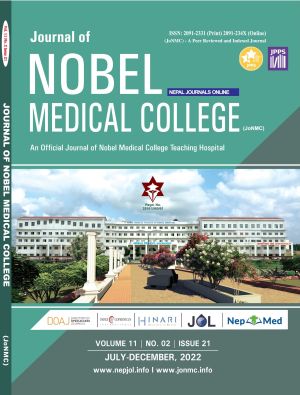Thyroid Dysfunction Associated with Depressive Disorder: A Descriptive Cross-Sectional Study Done in a Tertiary Care Center of Eastern Nepal
DOI:
https://doi.org/10.3126/jonmc.v11i2.50459Keywords:
Depression, Hyperthyroidism, Hypothyroidism, PrevalenceAbstract
Background: Depression is one of the most common psychiatric disorders with substantial morbidity and mortality. It is known to be associated with changes in the hypothalamic-pituitary-thyroid axis, thus may be accompanied by subtle thyroid dysfunction. Thus, our study aims to determine the prevalence and characteristics of thyroid dysfunction in newly diagnosed depressive patients.
Materials and Methods: A prospective descriptive cross sectional study was conducted among 130 patient diagnosed as depression from December 2020 to June 2022 after taking the ethical approval. The patients in the symptomatic phase and above 18 years was recruited in our study. Thyroid profile consisting of free tri-iodothyronine (FT3), free thyroxine (FT4) and thyroid-stimulating hormone (TSH) was estimated by chemiluminescence immunoassay in the central laboratory of Nobel Medical College Teaching Hospital.
Results: Out of 130 depressive patients recruited in our study, 44 patients had abnormal thyroid function test showing a prevalence of 33.84%. The most common form was moderate depression which was 39.99% of our study population. The commonest thyroid abnormality was subclinical hypothyroidism (15.38%) followed by overt hypothyroidism (14.61%). Thyroid abnormality was more common among the severe form of depression (46.66%). The comparison of means of fT3, fT4 and TSH between different grades of depression was statistically significant for fT3 (p=0.048) and TSH (p=0.001).
Conclusion: Thus, the most common thyroid function abnormalities in our study include subclinical and overt hypothyroidism, with associated lower level of fT4 and higher level of TSH.
Downloads
Downloads
Published
How to Cite
Issue
Section
License

This work is licensed under a Creative Commons Attribution 4.0 International License.
JoNMC applies the Creative Commons Attribution (CC BY) license to works we publish. Under this license, authors retain ownership of the copyright for their content, but they allow anyone to download, reuse, reprint, modify, distribute and/or copy the content as long as the original authors and source are cited.




